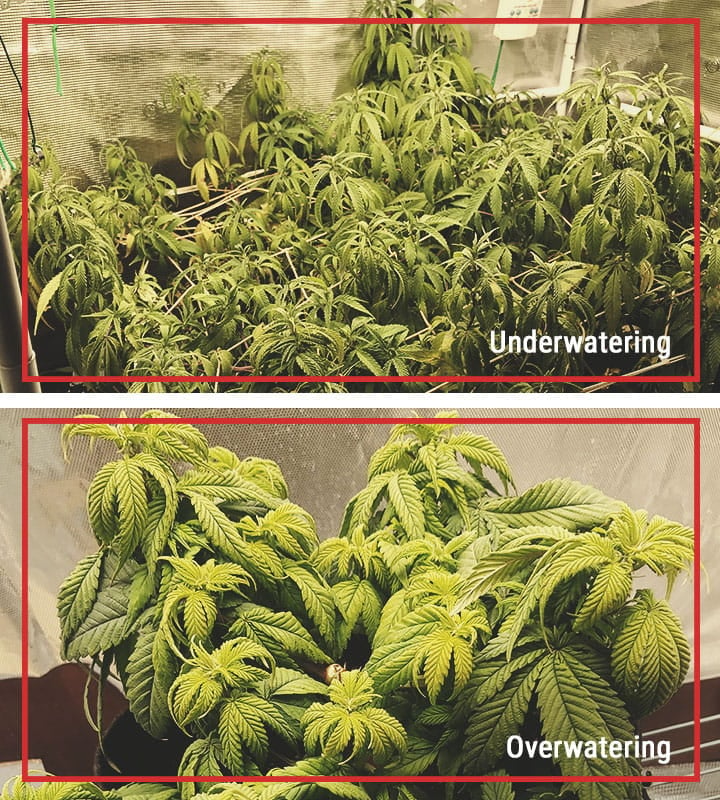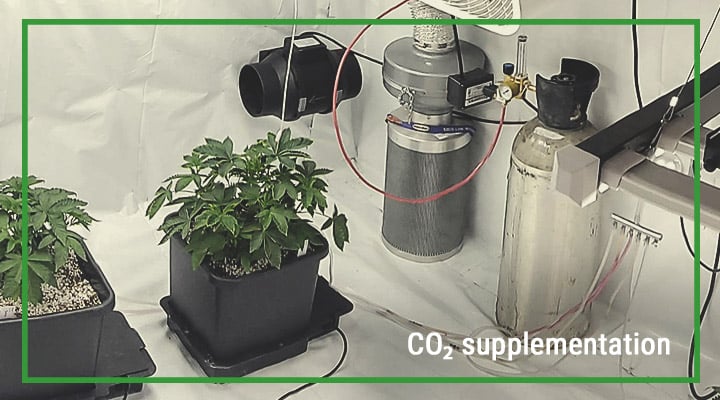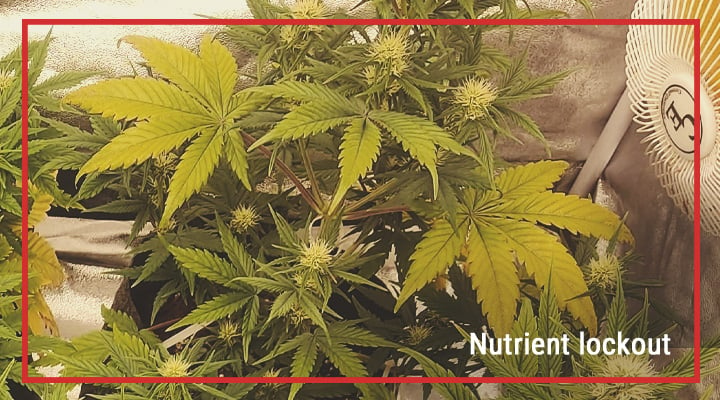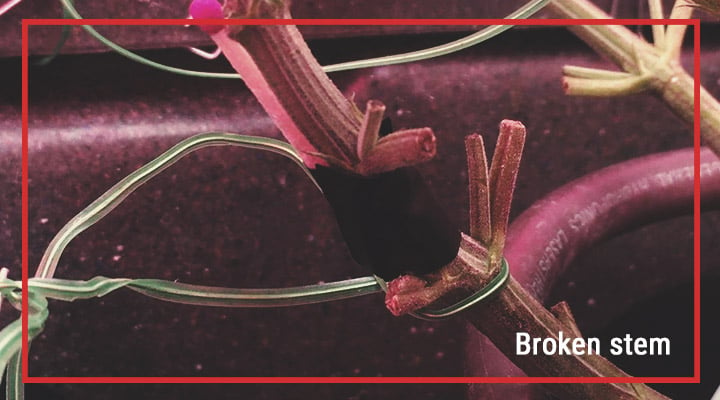.

Beneficial and Detrimental Forms of Stress in Weed Plants
Cannabis is a hardy plant that flourishes in a variety of conditions. As growers, however, there are a few ways we can interfere with our plants' grow cycle to induce stress and reap bigger, better harvests. But other forms of stress are just plain bad. Keep reading to learn all there is to know about good and bad stress for cannabis plants.
Contents:
- Water stress — beneficial and detrimental
- Root stress — detrimental
- Light stress — beneficial and detrimental
- Temperature and humidity — beneficial and detrimental
- Nutrient or fertiliser stress — detrimental
- Ph stress — detrimental
- Tissue damage — beneficial and detrimental
- Rethinking cannabis stress
For humans, the word stress is loaded with a ton of negative connotations. But for cannabis, a certain amount of “good” stress can actually help plants grow more healthily and produce bigger, more resinous flowers.
But how exactly do you know what kinds of stress are good for cannabis plants, and what aren't? In this article, we take a closer look at beneficial and detrimental forms of stress in cannabis, and how to use the former to ensure your plants produce the best possible harvest.
Water Stress — Beneficial and Detrimental
Cannabis plants need water to survive. Not only is it necessary for producing glucose to fuel photosynthesis, but water pressure also helps plants to maintain their internal structure. If they don’t get enough water, plants will suffer from stunted growth, wilting foliage, and, eventually, will die completely.
-
Detrimental Stress
Overwatering, however, can be just as detrimental to a plant’s health as underwatering—arguably even more so. Excess water in the substrate leads to a host of problems, interrupting nutrient uptake and stunting a plant’s growth, inflicting damage to your plant’s roots, and exposing it to pathogens such as fungi, bacteria, and pests.
At RQS, we definitely urge growers to err on the side of underwatering, especially if it's their first time growing cannabis. For best results, we recommend you pay close attention to your plant's soil and let the top few centimetres dry out completely before watering again. Don’t overdo it, though; letting your soil go bone-dry can cause an unhealthy degree of stress that’ll ultimately just stunt their growth.


-
Beneficial Stress
In terms of potentially beneficial applications of water stress in cannabis, some growers like to simulate pseudo-drought conditions in their grows, arguing that the right amount of underwatering helps to avoid pathogens and encourages plants to develop more cannabinoids and resin.
Another type of water stress some growers like to implement is known as “cold shock”. This involves flushing plants with cold water during the late flowering period, just prior to harvest. Again, the theory behind this method is that the slight stress caused by shocking the roots with cold water pushes the plants to produce more trichomes/resin in the final stretch of their life.

Root Stress — Detrimental
A plant’s root system is its lifeblood. Without healthy roots, your plants will never be able to support healthy vegetative growth or flowering. Hence, it is super important to care for the root system and minimise stress to this vital part of the cannabis organism, especially early on in the grow cycle.


Some of the most common stressors on cannabis roots include:
- Over or underwatering
- Hot or cold temperatures and abrupt temperature fluctuations
- Overfeeding (nutrient burn)
- Poor soil pH
- Rootbound
- Fusarium, Pythium, and other types of root fungi
The key factors to avoiding root stress are:
| Oxygen | Roots need oxygen to create ATP, a molecule that helps to transport molecular energy throughout a plant’s organism. Oxygen also helps to prevent the development of pathogens in the root system. |
| The right temperature | Cannabis roots are happiest at around 24°C when growing in soil, and between 19–25°C in hydroponics. At these temperatures, root respiration and nutrient uptake are at their most efficient. |
| Sufficient water and nutrients | Roots grow in constant search of nutrients and water to feed a plant’s growth. As the root system expands, you’ll want to abide by watering and feeding schedules that distribute sufficient water and nutrients to promote robust development, without overfeeding or overwatering. |
| Proper container size | If you choose to grow in containers, you’ll want to ensure each plant has ample room to spread out its root system. If the container is too small, plants will soon become rootbound, which can cause a host of other issues and will generally restrict the development of your crop. So either start out with a big-enough pot to support the entire life cycle, or pot on as necessary to give the subterranean part of your plants room to breathe. |
| Oxygen | Roots need oxygen to create ATP, a molecule that helps to transport molecular energy throughout a plant’s organism. Oxygen also helps to prevent the development of pathogens in the root system. |
| The right temperature | Cannabis roots are happiest at around 24°C when growing in soil, and between 19–25°C in hydroponics. At these temperatures, root respiration and nutrient uptake are at their most efficient. |
| Sufficient water and nutrients | Roots grow in constant search of nutrients and water to feed a plant’s growth. As the root system expands, you’ll want to abide by watering and feeding schedules that distribute sufficient water and nutrients to promote robust development, without overfeeding or overwatering. |
| Proper container size |
If you choose to grow in containers, you’ll want to ensure each plant has ample room to spread out its root system. If the container is too small, plants will soon become rootbound, which can cause a host of other issues and will generally restrict the development of your crop. So either start out with a big-enough pot to support the entire life cycle, or pot on as necessary to give the subterranean part of your plants room to breathe. |
Light Stress — Beneficial and Detrimental
Cannabis is a sun-loving plant, and every weed grower needs to understand the importance of giving their plants plenty of high-quality light throughout the grow cycle.
One of the main reasons light is so important for cannabis (and all other plants, in fact) is that it’s necessary for photosynthesis. If you’ve got a good memory, you might be able to recall how photosynthesis works from your high school biology class. But if you can’t, the basics are simple: plants use photosynthesis to turn light energy, water, and carbon dioxide from their environment into glucose, which they then use to fuel their growth. In short, light is the single most important energy source for cannabis plants.
In order to photosynthesise properly, outdoor cannabis plants need at least 6 hours of direct sunlight per day. If possible, 10–12 hours of direct sunlight is ideal. Indoors, most growers give their plants 18 hours of light during the vegetative growth phase, followed by 6 hours of uninterrupted darkness, which is just as important for plant growth. Then, when it comes time to flower, plants are switched to a 12/12 schedule indoors, or bloom naturally in time with the seasons outdoors.
-
Detrimental Stress
Unfortunately, mastering lighting for cannabis can be difficult, and light stress is arguably one of the most common issues we see growers dealing with (especially inexperienced cultivators).
The leading form of detrimental light stress growers encounter is light burn. This occurs when your grow lights are running too hot or positioned too close to your plants, burning your canopy as a result.
Light burn is very easy to spot, as it causes cannabis leaves to curl upward and close in on themselves in an attempt to be less exposed to the light. Over time, light burn will cause the foliage to become dry, brown, and brittle. Light burn is not a good form of stress, and should be avoided at all costs as it destroys healthy foliage and stunts plant growth.


-
Beneficial Stress
While light burn is detrimental to plant health, there is a way to use some “healthy” light stress to benefit their growth. To start, we recommend experimenting with the colour temperature/light spectrum of your lights.
Photosynthesis occurs at the highest rates in red light, followed by blue light. For the best results when growing indoors, we recommend using lights with a higher percentage of blue light during the vegetative stage (to promote the growth of healthy foliage and strong stems), followed by red light during the flowering stage (to promote flowering and resin production).
If you want to step things up a little, you may choose to boost (ever so gently) the UV light frequencies in your tent or grow room during flowering. Some growers find that a subtle increase in UVB light intensity can boost resin production during flowering. But implement these boosts gently, as UVB light is very strong and can burn your plants if too intense.
One final form of beneficial light stress among cannabis growers is light deprivation during the late bloom stage. This technique involves completely starving your plants of light for 24–48 hours prior to harvest, which reportedly helps to encourage trichome production just before cutting.

Temperature and Humidity — Beneficial and Detrimental
The temperature and humidity levels in your grow room are super important and have a direct impact on your plants’ ability to grow and flourish. While each strain is a little different, most growers agree that the best temperature and relative humidity levels for cannabis are:
- 20–25°C and 65–70% relative humidity for seedlings
- 22–28°C and 40–70% relative humidity for vegging plants (adjust humidity to genetics)
- 20–26°C and 40–50% relative humidity for flowering plants
Most cannabis strains enjoy slightly cooler nighttime temperatures. Where possible, try dropping the temperatures in your tent/room by 5–10°C during lights-off to promote respiration, nutrient and water uptake, and strong vegetative growth.
-
Detrimental Stress
Temperatures that are either too high or too low can cause heat and cold stress, both of which greatly affect the health of plants. Cold stress will cause plants to droop and eventually wilt—side effects of the plant’s inability to absorb nutrients and water to stay alive.
Heat stress has similar effects (namely, it affects a plant’s ability to uptake nutrients and water), but it manifests differently. Plants suffering from heat stress will droop, and over time their foliage will become dry and yellow before dying off completely. High heat and humidity also create the perfect breeding ground for pests and pathogens that can destroy healthy foliage and wreak havoc on your plants.


-
Beneficial Stress
However, as with a lot of aspects of cannabis growing, the right amount of temperature stress can, in some instances, prove beneficial to plant health. If, for example, you use CO₂ supplementation in your room or tent, you may be able to bring up the temperature, which can encourage plants to take up more water, fuelling photosynthesis and growth.
Similarly, many growers praise using cold stress in the final weeks of flowering. Some experienced cultivators have found that driving down the temperatures in a grow tent or room in a controlled manner two weeks prior to harvest can encourage plants to produce more trichomes and terpenes, resulting not only in more potent buds, but more aromatic ones to boot.

Nutrient or Fertiliser Stress — Detrimental
Feeding cannabis the right amount of nutrients is extremely important. And while most brands of fertiliser come with what seem to be pretty straightforward instructions, feeding is easily one of the most problematic aspects of cannabis growing. Many growers find themselves either underdoing the nutrients and harvesting subpar buds, or overdoing it, causing nutrient burn.
Nutrient burn occurs when plants are exposed to more chemical fertiliser than they can absorb. Over time, the chemicals from the fertiliser build up in the soil, damaging roots and interfering with a plant's ability to uptake water and nutrients in the future.
To avoid nutrient burn, we always recommend sticking to organic nutrients, as these are harder for plants to break down and absorb, making them less likely to cause nutrient burn. From here, follow a solid feeding schedule, and avoid the “more is always better” mentality.


pH Stress — Detrimental
Cannabis plants grown in soil require a pH of between 6 and 7. The pH level is a measure of how acidic or alkaline something is. Higher numbers—above 7—show that the soil is more alkaline, while numbers below 7 are more acidic.
Cannabis prefers something just about in the middle. You must keep the soil, water, and nutrients in this range, otherwise the plant will not be able to uptake nutrients—a phenomenon known as nutrient lockout—and can autumn victim to other forms of stress.
For hydroponics, the ideal pH range is a little lower—between 5.5–6.5. Whereas soil-grown plants can take a little more fluctuation, pH-related issues in hydro can quickly spell disaster for your crop, so make sure to measure your solution and substrate with a reliable pH meter.


Tissue Damage — Beneficial and Detrimental
Tissue damage is perhaps the most commonly utilised form of beneficial stress in cannabis plants. That said, it can also cause problems when performed incorrectly or at the wrong time.
-
Detrimental Stress
When plants suffer from broken branches or foliage, they dedicate a lot of energy to recovery. Part of this energy goes toward healing the broken tissue, and part of it goes toward strengthening the plant's defences against pests and pathogens that might be attracted to the damaged area.
When this happens, not only is the life cycle of the plant extended as it recovers, but it takes energy away from other key processes. Some common causes of unwanted tissue damage in cannabis include strong winds (watch out for signs of wind burn when growing outdoors), growing big, top-heavy plants in small pots, and simple mistakes when watering or moving plants around the garden.
While you can afford to make some small mistakes during the vegetative stage, if you break off a cola during late flowering, there’s not much you can do.


-
Beneficial Stress
On the other hand, growers can also use tissue damage to their advantage as a way to promote nutrient uptake, redirect plant growth, and increase light exposure to more parts of the plant. These techniques are often referred to as high-stress and low-stress training. Some examples of this include:
- Low-stress training (LST): This involves bending and tying down a weed plant's branches to encourage it to grow more horizontally. Many growers also use LST to increase light penetration to all potential bud sites.
- Defoliation: Removing fan leaves helps to accelerate sugar production in parts of the plant that benefit most, and also improves light penetration into a plant's canopy, promoting better bud development in lower areas of the plant.
- Topping, FIM, super cropping, lollipopping: These high-stress training techniques inflict physical stress on plants, forcing them to produce multiple main stems, take up more nutrients, or focus energy on the topmost parts of the plant, respectively. This kicks their gears into overdrive, ultimately resulting in more vigorous growth and bigger, better, more resinous harvests.
Bear in mind that timing is super important when it comes to training marijuana plants. Most growers agree that stress can be beneficial during the vegetative phase, but should be avoided (for the most part) during flowering to avoid interrupting flower and resin development. Also, high levels of stress in the flowering period may trigger hermaphroditism in some plants.

Rethinking Cannabis Stress
Cannabis is an extremely hardy plant. And while it grows fine on its own, the right dose of controlled stress can push plants to develop faster and with more vigour during the veg phase, and churn out bigger, more resinous flowers during bloom. That said, other forms of stress are best avoided, and will only work to damage the health and harvest of your crop. So always be careful when dealing with stressed weed plants. While we all benefit from a little push, you never want to take things too far.







































